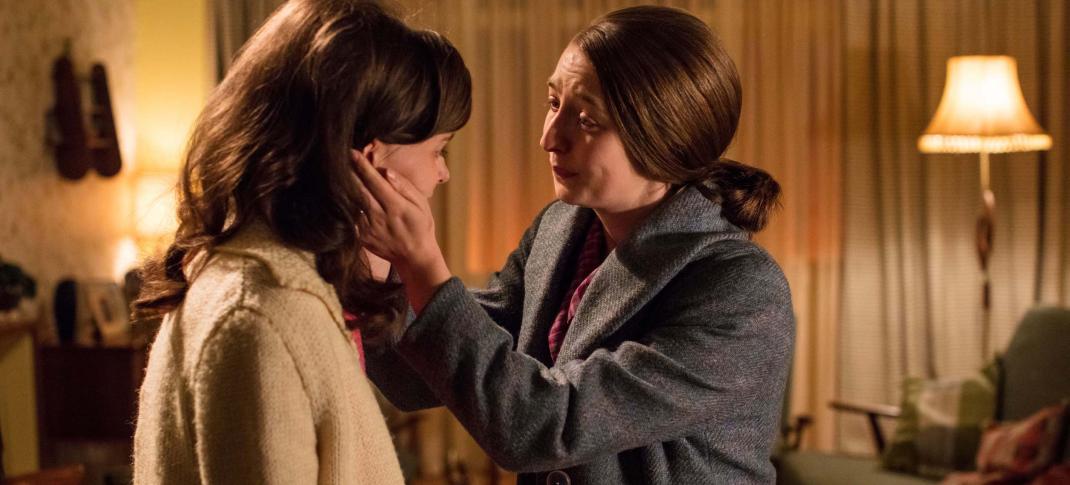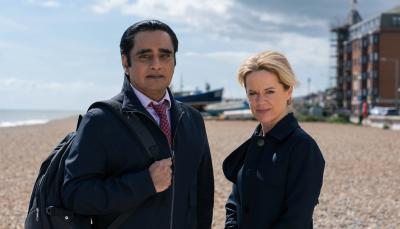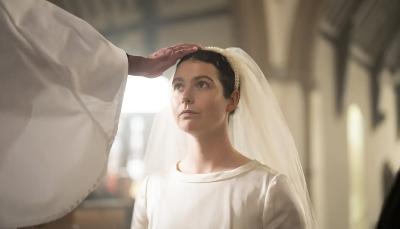Midwife Means "With Woman": 'Call the Midwife' and the History of Abortion in England

Picture Shows: Cath Hindman (EMILY BARBER), Lesley Whyte (JORDON STEVENS)
Neal Street Productions
Nurse Valerie Dyer: Did we do the right thing? Bringing her here?
Mother Julienne: The word midwife means with woman. A woman in that situation needs someone by her side whatever mistakes or choices brought her to our door.
It’s 1964 and things are changing in Poplar on Call the Midwife.
A dad actually asks to be at the, ah, interesting end of his child’s birth and is firmly put in his place, and more women want to give birth in hospitals. Hemlines are rising as Britain becomes a fashion powerhouse. Yet some things just don’t change. As now, an obsession with royal births rules (and if you really want to know, apparently bets are now at 1:2 that Meghan and Harry’s baby will be a girl, with the top name predicted to be Diana. Yes, British bookies do big business during royal pregnancies). And sadly, not every birth is joyfully anticipated, and many women, particularly poor women in an area like Poplar, have few options for help.
Call the Midwife has featured abortion-related storylines in the past but this is the first time the issue has been dealt with in such a graphic fashion. If this is a subject that may cause you offence or upset you, please be warned.
Aspiring fashion model Cath (Emily Barber) finds herself “in trouble.” She admits to her sister Lesley (Jordon Stevens), who has just had a baby herself, that she is “in the family way”—it is painful to see how difficult it is, even for sisters, to talk about such a desperate and shameful condition. And it was shameful in the early 1960s, particularly for a working-class woman trying to support herself and with no husband in sight. Cath does the only thing she feels she can do under the circumstane: visit an abortionist. But, in her words, the procedure “hasn’t come on naturally.” She is in all sorts of trouble.
In 1964, the 1861 Offences Against the Person Act was still the law, which that meant anyone undergoing, or helping a woman with an abortion, could face life imprisonment. The first anti-abortion act, the Ellenborough Act in 1803 made abortion after quickening (i.e. experiencing foetal movement) punishable by death. Before then, things were a little more relaxed. The first reference to abortion in English law appeared in the 13th century, declaring that until quickening the foetus was an integral part of the mother’s body and had no soul. (And quite honestly some of the pregnancy tests of the medieval period were just bizarre.)
Why did the law become involved? Almost certainly because male doctors started taking an interest in the previously female concerns of childbirth during the eighteenth century.
Although the “man-midwife” or accoucheur, was initially viewed with scorn and derision, they eventually began to dominate the profession for the upper and middle classes. They also introduced forceps which could save lives (as in this Call the Midwife episode), but often, in unskilled hands, didn’t. One of the most notorious episodes of male incompetency in the field was the 1817 death of Princess Charlotte, the daughter of the Prince of Wales (later George IV). She received treatment from a renowned royal physician, Sir Richard Croft, who prescribed a low protein (“lowering”) diet and frequent bloodlettings during her pregnancy. After 50 hours of labor, she died shortly after delivering a stillborn baby boy. Distraught and ruined, Croft committed suicide a few weeks later.
That’s not to say that midwifery had a feminist golden age before male doctors removed their gloves and hats and pitched in. Abortion methods could be unreliable and frequently dangerous, as were most medical procedures, including childbirth. As medicine made advances, it becomes clear that those with money fared much better than those without. A wealthy woman dealing with an unwanted pregnancy in 1964 had far more resources and chances of a much better outcome than Cath did, even if both were breaking the same law. Another PBS offering, Breathless (2014) starring Jack Davenport, explores the highly illegal world of a charismatic surgeon and his abortion team.

Set in a world similar to that of 1964 Poplar, Mike Leigh’s movie Vera Drake (2004) stars Imelda Staunton as an abortionist in post-war England, helping out working-class women with an innocent cheer and naivety which leads to her arrest and downfall. Staunton is one of those “in everything” British actors: Lady Bagford in the upcoming Downton Abbey movie, the Nurse in Shakespeare in Love (1998), Miss Pole in Cranford (2007-2010), the villainous Dolores Umbridge in Harry Potter and the Order of the Phoenix.
Abortion finally became decriminalized in England when the 1967 Abortion Act became law. This law, one of the most liberal in Europe, allowed abortion up to 24 weeks and took into consideration the woman’s health, situation, and family. There were a couple of interesting results—one being that faster and more accurate pregnancy tests were developed to meet the 24-week deadline. For years, “the rabbit died” was shorthand for a positive pregnancy test. It referred to an early, slow, and expensive process in which urine was injected into a rabbit or other small animal. Pregnancy hormones stimulated ovulation in the animal if the result was positive. And the only way the lab could find that out—well, the rabbit died.
The other result, astonishingly—we are talking about Brits after all—was that women from all classes and walks of life found they were able to break decades of silence by talking about abortion and finding they were not alone in their experiences. Abortion had gone underground for decades, networks forming among medical professionals and others. A network, that in this episode of Call the Midwife, includes the women of Nonnatus House. Didn't you notice the seamless integration of the nuns downstairs keeping Sgt. Woolf (who could arrest them all!) interested in the possibility of cake, while the midwives swing into action upstairs?
The abortion storyline will continue throughout Season 8 - according to actress Jennifer Kirby and the Radio Times - so we'll have the chance to talk about this further and, hopefully, to see a continuation of Cath's story in some way. What did you think of this episode and of Call the Midwife's handling of such a sensitive issue??




